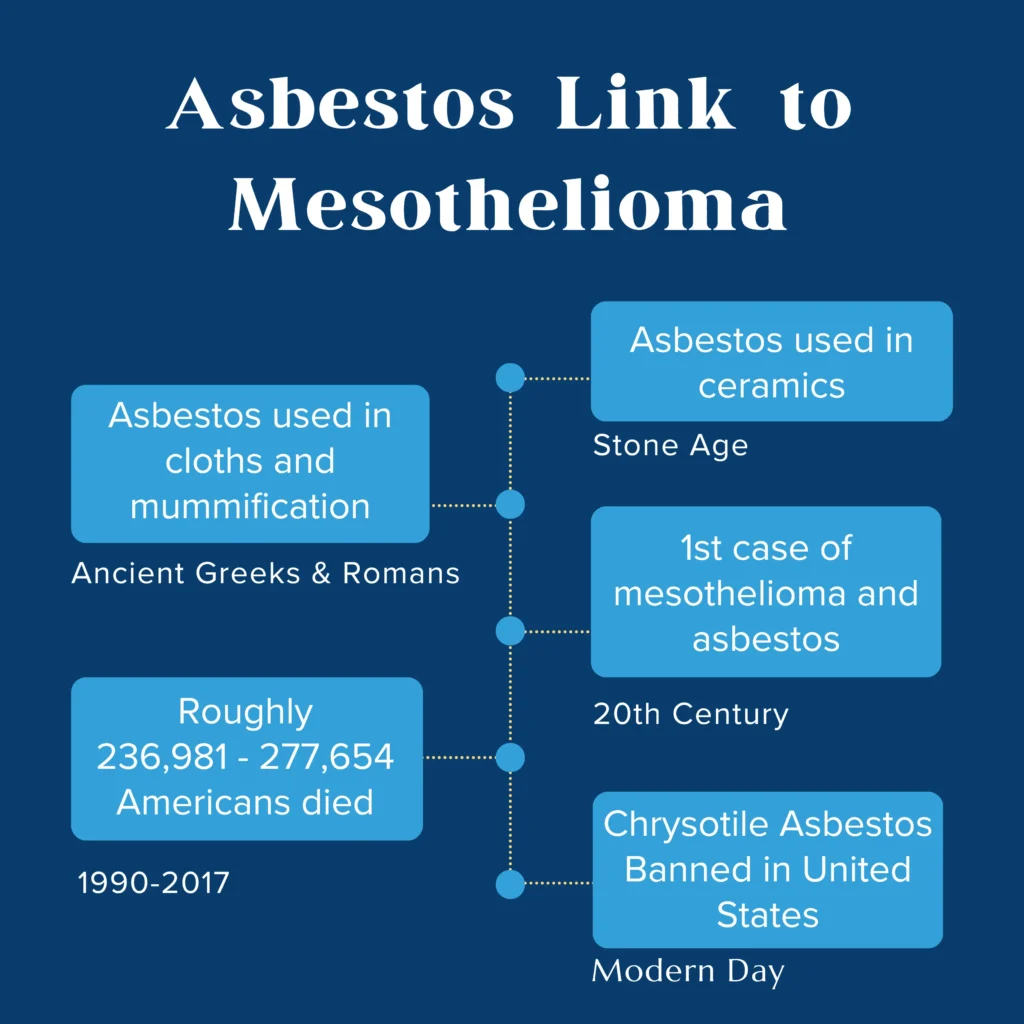The journey of asbestos to mesothelioma is complex and eventful. From its birth in the stone age history to its modern-day uses in everyday products, asbestos has persisted in many places around the world. Valuable lessons have been learned throughout this journey and the rich history is one for doctors and patients to not only learn from but to be used as a roadmap of all the challenges that were encountered. Roughly 3,000 mesothelioma cases occur each year in the United States alone and this number has slowly declined from the growth phase of 1970 to 1990. It is easy to imagine how large this number totaled over its commercialization in the 20th century and how many people were unfortunately impacted by these fibers.

Asbestos is a naturally occurring mineral that is recognized for its heat-resistant insulation properties. It can be found and mixed into many different products like paint, tiles, and cement. While the mineral can be used without being hazardous, if crumbled or damaged, asbestos exposure can occur. When it is pulverized, the dust is carried into the air and can easily enter the lungs of workers or nearby families. The occurrence of this has led OSHA to require companies to wet the fiber before use to prevent this. Unfortunately, this was after the multiple studies and tests conducted to validate the link of asbestos to mesothelioma. Mesothelioma is a rare type of cancer that attacks the mesothelial tissue surrounding organs like the lungs most frequently, the abdomen, heart, and testicles. Let’s dive into this history a bit further.
Stone Age
Asbestos was said to have been first discovered in the Stone Age. It was primarily used as a “temper or strengthener for ceramics” to aid in cooking for these individuals(History of Asbestos, 2021). It is suggested by archaeologists that the asbestos was crushed using their hands and often “helped to strengthen the vessels and prevent cracking” (Clay Pot Cooking: A Historic Evolution, 2020). At this point, there was no connection to mesothelioma or other asbestos-related diseases.
Ancient Greeks and Romans
The ancient Greeks grew very fond of asbestos and used it in many items we can recognize today. When an individual was mummified and preserved, the Greeks and Romans found it useful to apply the naturally occurring mineral into the weave of the cloth that surrounded these individuals. In addition to this, asbestos was used in candles, napkins, tablecloths, and clothing. The name “asbestos” was also granted by the Greeks and is defined as “inextinguishable” which helps to paint the image that it is everlasting(History of Asbestos, 2021). The harmful effects of asbestos were quick to follow in the next time period.
20th Century – Asbestos and Mesothelioma
The beginning of the asbestos boom occurred early in the 20th century. At this point, there were no reported cases with the term malignant mesothelioma and asbestos being related. After the discovery of asbestos mines were found in the United Kingdom, China, and the United States, mass production began to occur. It found purpose in many construction materials, shipyards, and navy materials. The rise in asbestos use, unfortunately, led to the discovery of the very first malignant mesothelioma case occurring in 1946. Quickly after, in the year 1960, less than two
decades later, “Wagner et al. reported an MM epidemic among asbestos miners and first demonstrated a relationship between asbestos exposure and MM” as reported by the National Library of Medicine. J.C. Wagner, a South African researcher, was the first researcher to connect the asbestos to mesothelioma. Later in 1964 and 1965, articles began being published about the workers who were at high risk of developing mesothelioma. Some of these positions included:
· Asbestos miners
· Construction workers
· Pipefitters
· Carpenters
Statistics and facts surrounding the median age, latency period, symptoms, and types of exposure began to be identified and further investigated. In addition to this, it was still being investigated that individuals living near asbestos mines ( secondary exposure) were at risk as there was no definite causation that was shown. While this was the case the EPA created a partial band in 1989 that restricted the “import, processing, and distribution of some asbestos-containing products. EPA also banned new uses of asbestos which prevented new asbestos products from entering the marketplace after August 25, 1989” (EPA Actions to Protect the Public from Exposure to Asbestos | US EPA, 2013).
Modern Asbestos and Mesothelioma
Understanding asbestos and mesothelioma has come a long way. Following the 20th century, research and action have been taken to prevent the occurrence of mesothelioma cases. From 1990 to 2017, Asbestos Nation claimed that “an estimated 236,981 to 277,654 Americans died from asbestos exposure”. While this number is unsettling, it helped doctors to further research products in which asbestos is found and recognize them as hazardous. It is additionally recognized by the Environmental Protection Agency that “exposure may occur only when the asbestos-containing material is disturbed or damaged in some way to release particles and fibers into the air”.
In addition to this, OSHA began to create safety requirements like requiring face shields or gloves for industries using asbestos-like chemical plants, electrical manufacturing plants, and power plants. While the partial ban was in place, in March of 2024, a full ban on chrysotile asbestos was placed in the United States. The EPA described this ban as “The rule prohibits ongoing uses of the only known form of asbestos currently imported, processed and distributed in the U.S., and will protect people from lung cancer, mesothelioma, ovarian cancer, laryngeal cancer and other health problems caused by asbestos exposure”.
If you or someone you know has been affected by mesothelioma or another asbestos-related disease in the state of Pennsylvania, please fill out this form for a free consultation or call 1 (800) 505-6000 for legal help.
Sources:
https://www.oracleasbestos.com/what-is-asbestos/history-of-asbestos/
https://www.ncbi.nlm.nih.gov/pmc/articles/PMC1742940/pdf/v080p00072.pdf
https://www.epa.gov/asbestos/epa-actions-protect-public-exposure-asbestos